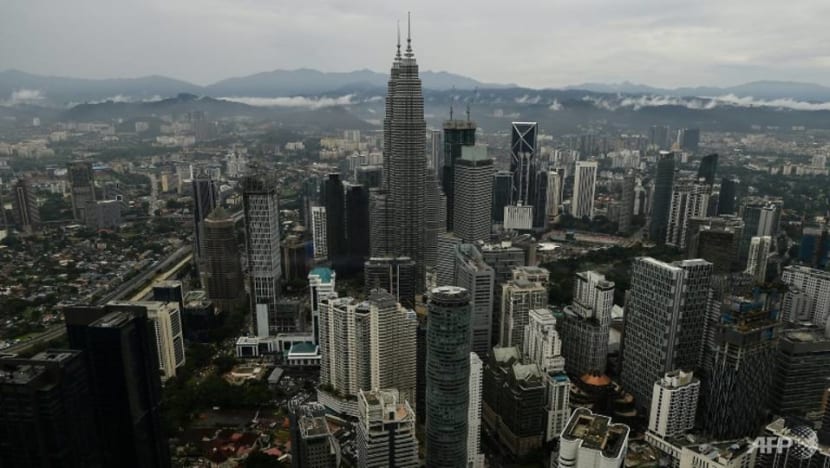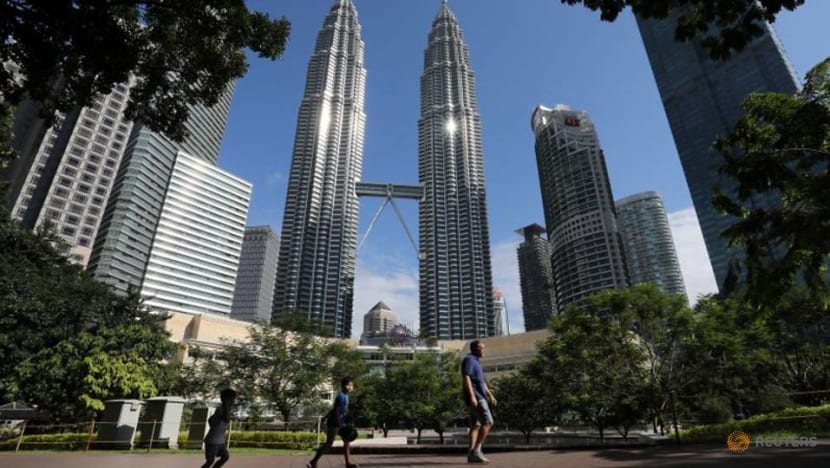commentary Commentary
Commentary: Malaysia's economy has surprised many despite COVID-19. But for how long more?
Demand from consumers underpinned the economy’s resilience in the first quarter but an over-reliance on private consumption is also cause for concern, says OCBC economist Wellian Wiranto.

File photo. (Photo: AFP/Mohd Rasfan)
SINGAPORE: Given the onslaught of events of late – low oil prices, supply chain disruptions, political drama and a pandemic – everyone expected the Malaysian economy to shrink in the first quarter of 2020.
But Malaysia surprised everyone with the latest data released on Wednesday (May 13): Its economy grew 0.7 per cent from the year before, beating the median expectation of -1 per cent and ours at the bank, which stood at -4 per cent.
In normal circumstances, it would have been disastrous for Malaysia to announce GDP growth of anything less than 4 per cent, given that the last time it fell below that pace of expansion was more than a decade ago.
As a sign of how drastically circumstances have changed as a result of COVID-19 however, the 0.7 per cent uptick has instead brought some cheer.
READ: Commentary: Hong Kong will keep its chin up this COVID-19 outbreak and enjoy the small things
The strength of consumers to power on in the first quarter, come what may, is not to be underestimated as household consumption still rose 6.7 per cent despite the pandemic.
WORRYING SIGNS IN SOME SEGMENTS
Even so, it is important to put things in context.
To be sure, the momentum of economic growth has weakened considerably. This is still the lowest year-on-year growth since the third quarter of 2009, and the first time GDP has seen an outright contraction in at least a decade.
We might also lose any sense of joy when we examine certain components of the economy.
For one, the exports segment is clearly showing signs of damage, no thanks to supply-chain disruptions at the start of the first quarter, followed by an unforgiving combination of production shutdowns and an evaporation of demand later.
It shrank by 7.1 per cent from a year earlier, and essentially lopped off a significant 4.7 percentage points from headline growth.
Despite some shrinkage in imports to balance things out, net exports nonetheless showed a hefty 37 per cent drop in the first quarter, compared to the year before.
The slump in shipments to China, especially at the start of the year, was the primary culprit.
While China’s demand recovered somewhat by March, it came at a time when shipments to other key destinations, such as the United States and Japan, started to weaken.

Investment activities also shrank considerably, at 2.3 per cent less than the year before.
While not a tremendous dip from the -2.1 per cent average for 2019, it is nevertheless still a drag on first quarter growth, and can only be even more so in the second quarter given the greater challenges.
While global outlook ought to improve in the second half of the year as countries ease their lockdown measures, most businesses are likely to hesitate before committing to any large-scale expansion of capacity.
READ: Commentary: Emerging markets need fresh finance not debt moratoriums
This is no thanks to the lingering uncertainties on the resurgence of an outbreak. Any uptick in domestic political volatility would not help either.
CONSUMPTION REMAINS STRONG, BUT FOR HOW LONG?
There are some silver linings, however. Compared to the other components, private consumption has held up remarkably well, growing 6.7 per cent compared to the year before.
Although this is an obvious drop from the 7.6 per cent average we saw in 2019, but the latest figure highlights the resilience of consumer demand, despite economic and health uncertainties.
This could be attributed to cash handouts to the poorest 40 per cent of the population and single adults, as part of the government’s RM260 billion (S$85 billion) stimulus package, as well as the wage subsidy scheme.
Given the increasing share that private consumption commands in the economy – nearly 62 per cent now, compared to the average of 57 per cent and 59 per cent in the last two years – it is both heartening to see its lingering strength in the first quarter.
But here is also a cause for concern to consider its prospects in the second quarter.
For one, if the bulk of the private consumption strength turns out to be due to frontloaded purchases ahead of the Movement Control Order (MCO) imposed in mid-March, then that would obviously leave a gap in the second quarter, which has spent most of its duration under the movement constraints of the MCO.

Then there is also the issue of much poorer employment prospects to contend with now, compared to a few months ago.
Already, the statistics office has noted a pick up in the unemployment rate in March, at 3.9 per cent, compared to 3.3 per cent in February.
April would most likely see it cross 4 per cent - a harbinger of diminishing purchasing power, especially against the structural backdrop of high household debt.
ENOUGH UNCERTAINTIES LOOM AHEAD
So what should we make of all this?
In short, as much as we can take comfort in the resilience in the first quarter’s GDP data and, in particular, private consumption, we should be cautious about what comes next.
READ: Commentary: Why lifting lockdowns and easing restrictions will be harder for some countries
Already, Bank Negara Malaysia (BNM) has noted that it expects an outright year-on-year contraction in the next quarter.
Our sense is that the economy may see a contraction as deep as -6.0 per cent year-on-year during the period, before eking out some gains in the second half of 2020 to allow it to post growth of -0.5 per cent for the year.
Having already slashed rates by 100 basis points rate to a historic low this year, Bank Negara is likely to keep the rest of its powder dry for now.
This would leave its overnight policy rate – the target rate for the day-to-day liquidity operations - unchanged at 2 per cent.

But if there is any indication that growth momentum would slow significantly despite easing the MCO, the central bank will not flinch at cutting the rate further to 1.5 per cent.
Even though the baseline scenario we have in mind is fairly subdued, this outlook unfortunately still comes with plenty of caveats. This includes no more need for any re-imposition of restriction orders after the latest one runs its course on Jun 9.
READ: Commentary: Wheels set in motion for another political showdown in Malaysia
As well, with the political temperature heating up yet again ahead of the reopening of the Parliament, any further twists in political Malaysia’s political drama, which reached new lows in February, will inadvertently hurt the path towards recovery.
Finally, on the global front, there is also the base assumption that the major economies can recover enough ground without endangering second waves of outbreaks that threaten to shut them all once more.
LISTEN: Why lifting lockdowns and easing restrictions may be the biggest COVID-19 test facing countries
BOOKMARK THIS: Our comprehensive coverage of the coronavirus outbreak and its developments
Download our app or subscribe to our Telegram channel for the latest updates on the COVID-19 outbreak: https://cna.asia/telegram
Wellian Wiranto is an Economist at OCBC Bank.














